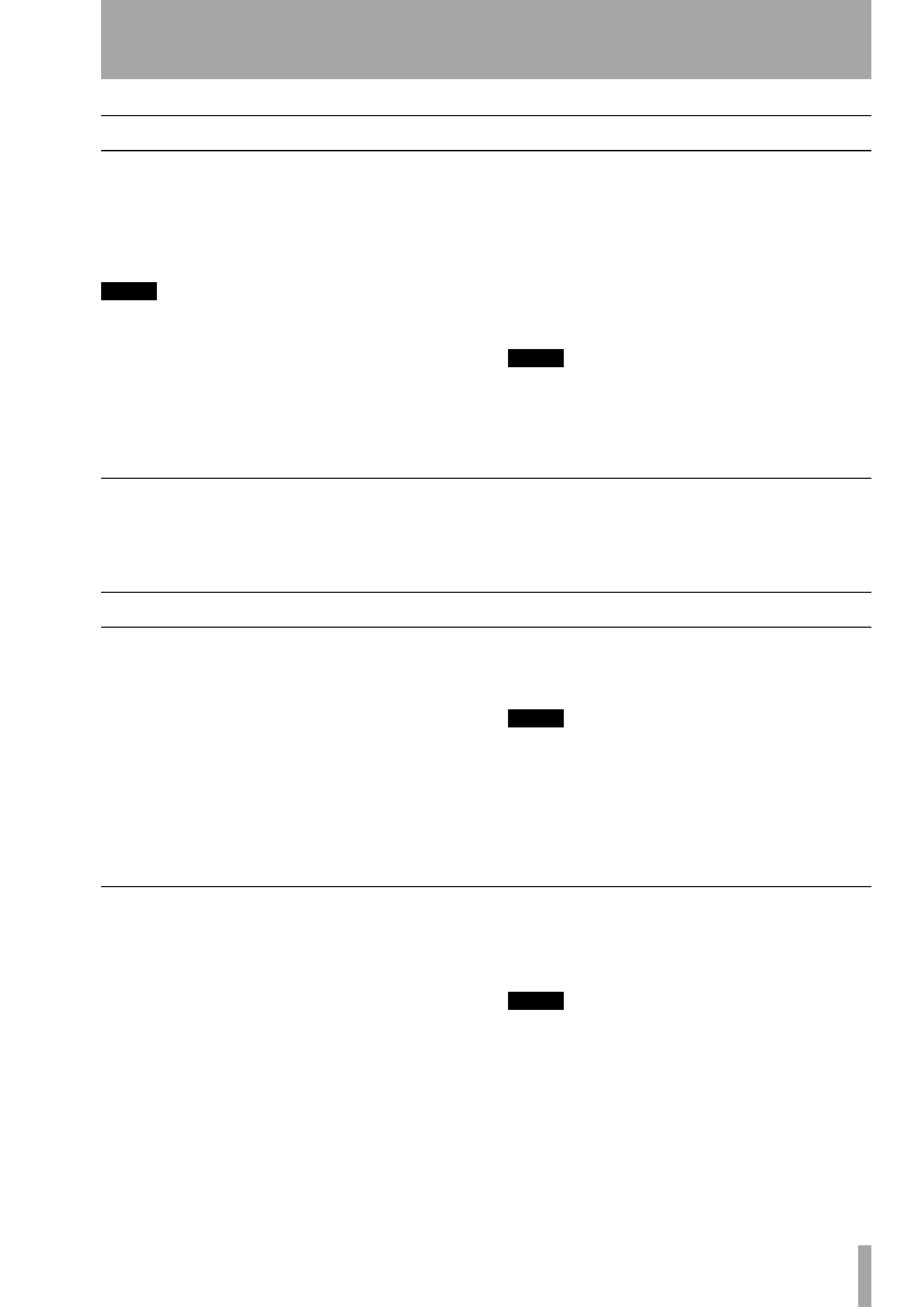
TASCAM US-122 Application Notes
1
Using the US-122 with GigaStudio and Cubasis
To use the US-122 with the supplied GigaStudio 24
and Cubasis applications together on Windows, you
will need to carry out the following steps after install-
ing the latest US-122 drivers, Cubasis and GigaStu-
dio. Ensure that the GigaStudio is installed in
accordance with the instructions contained in the
README file on the CD-ROM.
A technical note on different audio data types
In common with the other products in the TASCAM
series of USB audio interfaces, the (Windows) driv-
ers for the US-122 provides kernel-level mixing of
audio data sent to the unit. There are three types of
client: WDM, ASIO and GSIF, and the audio from up
to one client of each type (this is, up to three sources)
is mixed at unity gain, with saturation logic applied
to preserve the range. This applies to all versions of
Windows supported by the US-122 and there is very
little system overhead involved
In practical terms, this means that you can use Giga-
Studio (a GSIF client) together with Cubasis (an
ASIO client), at the same time, with the output of
both programs being sent to the US-122 outputs
simultaneously.
Setting up the GigaStudio 24 application
1
Launch the GigaStudio application.
2
Under the View / Settings menu, select the
Choose Hardware/Routing tab.
3
Use US-122 for the Hardware choice.
In the GigaStudio 24 Select Library function:
1
Under View / Port1, double-click the appro-
priate MIDI channel, to bring up a popup
window.
2
Choose the correct library file (.gig file) from
the Gigs folder (this "Gigs" folder should
have been specified when you installed Giga-
Studio).
Cubasis
1
Launch the Cubasis application.
2
Under the Options / MIDI Setup / System menu,
choose US-122 as the MIDI input.
3
Make sure the MIDI thru function is turned
ON.
4
On the Arrange window, choose Nemesys Midi
Port1 as the output destination for the MIDI
track corresponding to the GigaStudio chan-
nel you have set up earlier.

2 TASCAM US-122 Application Notes
Cubase SX/SL
Cubase SX/SL is very similar in both its Mac OS X
and Windows implementations.
Before setting up the US-122 to work with Cubase,
please install the latest US-122 drivers. Begin the
setup procedure below with the US-122 plugged in.
If you have not already done so, install Cubase SX or
SL.
Setting up MIDI
Use the MIDI System panel of the Devices/Device Setup
window to select the US-122 as the default MIDI
input and output.
Note that this does not mean that the US-122 is the
only MIDI device that can be used in your projects,
but it does make it the first choice.
Setting up audio
Use the VST Multitrack panel of the Devices/Device
Setup
window to select the US-122 in the ASIO Driver
section for input and output.
The sampling frequency, etc. is set in the project set-
tings.
Set the Audio Buffer Size to an appropriate setting
(this depends on your computer, etc., so it is impossi-
ble to make hard and fast recommendations).
For a detailed discussion of latency-related issues,
see the Cubase SX/SL Getting Started manual,
pp4448.
In the Windows version, you can use the Control
Panel
button to bring up the US-122 control panel. In
OS X, you must launch this from /Applications.
Use the panel brought up by the Devices/VST Inputs
menu item to enable and disable the two inputs of the
US-122 as required (they can be enabled and dis-
abled only as a pair). You can rename them here if
you want, and this name will appear in all mixer, etc.
settings.

TASCAM US-122 Application Notes
3
Cubase VST
Windows
Before setting up the US-122 to work with Cubase,
please install the latest US-122 v3.0 drivers. Begin
the setup procedure below with the US-122 plugged
in. If you have not already done so, install Cubase
VST
NOTE
Several revisions and bug fixes were implemented
in subsequent updates to VST 5. We suggest you
visit Steinberg's Web site and make sure you have
the most current version.
Open the Cubase application.
Under the Options / Audio Setup / System menu,
locate the ASIO DEVICE selector and choose one of the
US-122's ASIO drivers (16 or 24 bit) as the device.
Under VST INPUTS, make sure both pairs of inputs are
open (green input indicators are lit).
Also set up the MIDI inputs and outputs using the
Option
/ MIDI / System menu, and select the US-122
for input and output.
NOTE
These parameters save with the song and are not glo-
bally remembered. You will need to save the song as
DEF.ALL if you want the US-122 setup to load automati-
cally.
With Cubase 3.7 and earlier:
Open the Cubase application.
From the AUDIO pulldown menu, choose SYSTEM. In
the ASIO dropdown menu, select the US-122 16-bit
or 24-bit ASIO drivers.
Mac OS
Open the Cubase application.
From the Options pulldown menu, choose MIDI /
Setup / System.
Under OMS COMPATIBILITY, select IN
AND OUT
.
Still under the Options / MIDI Setup / System menu,
open the Input From menu and enable the US-122
MIDI inputs and outputs.
Under the Options / Audio Setup / System menu,
locate the ASIO Device selector and choose one of the
US-122's ASIO drivers (16 or 24-bit) as the device.
NOTE
These parameters save with the song and are not glo-
bally remembered.You will need to save the song as
DEF.ALL if you want the OMS MIDI setup to load auto-
matically.
You should now be ready to use Cubase 5.0 with the
US-122.
With Cubase 4.1 and earlier:
Open the Cubase application.
From the Options pulldown menu, choose MIDI Setup
/ System. Under Oms Compatibility, select IN AND
OUT
.
Still under the Options / MIDI Setup / System menu,
open the INPUT FROM dialog and enable the US-122
MIDI connectivity.
Under the Options / Audio Setup / System menu,
locate the ASIO Device selector and choose one of the
US-122's ASIO drivers (16 or 24-bit) as the device.
NOTE
These parameters save with the song and are not glo-
bally remembered. You will need to save the song as
DEF.ALL if you want the OMS MIDI setup to load auto-
matically.
You should now be ready to use your Cubase with the
US-122.

4 TASCAM US-122 Application Notes
Nuendo -- Windows and Mac OS
Before setting up the US-122 to work with Nuendo,
please install the latest US-122 v3.0 drivers. (Refer to
the document on installing the US-122 drivers with
either Win98SE/ME or Win2000.)
Begin the setup procedure below with the US-122
plugged in. If you have not already done so, install
Nuendo.
Installing the US-122 under Nuendo:
Open the Nuendo application
From the Devices menu, choose Device Setup.
Select the Add/Remove tab. Select TASCAM US-122
from the device menu and click ADD. TASCAM US-
122
should appear on the list of loaded devices on the
left side of the window.
Highlight VST Multitrack. In the ASIO Driver pull-
down menu, select the ASIO US-122 (16- or 24-bit)
driver.
Highlight Default MIDI Ports. Select US-122 MIDI
from the INPUT and OUTPUT drop-down menus.
From the Devices menu, choose VST Inputs. Make
sure the pair of inputs of the US-122 is set to active.
If you're running Nuendo for the first time, you'll
need to create a new project.
Select File/New Project, and choose Empty Project.
You'll then need to add tracks to the project. Select
the Project/Add Tracks menu. This can be done one at
a time by choosing the type of track (Audio, MIDI or
Group
), or by selecting Multiple.

TASCAM US-122 Application Notes
5
ProTools -- Windows and Mac OS
Pro Tools Free: This free software application
offers eight tracks of digital audio and 48 tracks of
MIDI. You can record up to two inputs simulta-
neously.
Before using the set-up information provided in this
chapter, first install Pro Tools Free (and OMS if
you're on a Mac) as described in the ProTools docu-
ment PT FREE Quick Start Guide.pdf that comes with
the Pro Tools Free download.
Make sure that Pro Tools Free is working using your
computer's built-in speaker before proceeding fur-
ther. You can use the sample project provided with
Pro Tools Free to test it.
To use the US-122 in this set-up, you must have the
latest version of the US-122 driver installed on your
system.
Before using this set-up document, first read the doc-
umentation on installing the US-122 drivers.
US-122 setup
You might need to adjust the audio latency for your
system. Do this in the System tab of the US-122 con-
trol panel.
Using a smaller setting will reduce the audio input to
output latency through Pro Tools Free, but also
increases the chance of audio drop outs. A setting of
1024 works well on many computers.
If you get an error message when playing that says
You're running out of CPU power.Take out some plug-
ins to free up CPU power
then you should first try
increasing your latency setting. You might also adjust
your CPU usage limit under the Setups/Hardware
menu item. For advice on low-latency input monitor-
ing, see the Input Monitoring section below.
Input Monitoring
With Pro Tools Free, you can monitor your inputs
using on-screen controls, including listening to plug-
in effects applied to input in real time. As an engi-
neer, this can be quite handy, but as a performer it is
less than ideal since the input to output latency (time
delay from input to output signal) is tens of millisec-
onds long. That's long enough to ruin your timing if
you are trying to record while listening to previously
recorded tracks (overdubbing).
For ultra-low latency monitoring (<1.5msec), you
can instead use the US-122's hardware input moni-
toring feature.
Using this technique, you won't hear plug-in effects
being applied to your inputs, but your timing will be
rock solid. Here's how to do it:
1
For record-enabled tracks, assign their out-
put to an unused bus. This way, you won't
hear Pro Tools' high-latency monitor output.
2
Use the DIRECT switch on the US-122 to
enable direct monitoring. Adjust the level
with the DIRECT MONITOR control. You can
also fold the direct monitor signal to mono
using the MONO switch.
